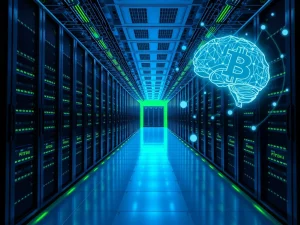Unleash Unprecedented Insights: 5 Ways AI Crypto Whale Tracking Transforms Your Trading
The cryptocurrency market moves quickly. Price shifts can happen in moments. Large investors, often called crypto whales, significantly influence these changes. Imagine knowing their next moves before they happen. This ability could transform your trading strategy. Fortunately, AI crypto whale tracking offers a powerful, predictive solution. It moves you from reacting to market events to anticipating them.
Decoding Crypto Whale Moves with AI
Crypto whales are major holders of digital assets. Their large transactions can trigger significant market volatility. A single massive sale or purchase impacts token prices. For instance, a major Bitcoin whale’s substantial liquidation once caused a rapid market downturn. This event liquidated millions in leveraged positions. Early knowledge of such moves allows traders to hedge risks. They can adjust exposure or even enter the market strategically. This turns potential chaos into opportunity. Artificial intelligence now provides tools to detect these critical movements. It flags anomalous wallet activity. AI sorts through vast onchain data. It highlights whale patterns that often hint at future price shifts. This article explains how AI assists in identifying upcoming whale wallet movements. We will explore various tactics used by advanced traders.
The Power of Onchain Data Analysis
The simplest application of AI for whale spotting involves filtering. An AI model can recognize and flag transactions. It identifies those exceeding a predefined value threshold. Consider a transfer worth over $1 million in Ether (ETH). Traders typically monitor such activity. They use a blockchain data API for real-time transaction streams. Subsequently, simple rule-based logic is built into the AI. This logic monitors the data flow. It picks out transactions meeting preset conditions. For example, the AI might detect unusually large transfers. It could also spot movements from known whale wallets. Sometimes, it identifies a mix of both. The result is a custom “whale-only” feed. This automates the initial stage of onchain data analysis. It provides immediate insights.
Real-Time Crypto Whale Tracking Feeds
Gaining visibility is key in volatile markets. You move beyond just price charts. You observe the actual transactions driving those charts. This initial layer of crypto whale tracking empowers proactive trading.
Here’s how to connect and filter with a blockchain API:
- Step 1: Choose an API Provider. Select a reliable blockchain API provider. Options include Alchemy, Infura, or QuickNode.
- Step 2: Generate API Key. Obtain an API key. Configure your AI script to pull real-time transaction data.
- Step 3: Define Query Parameters. Use query parameters. Filter for your target criteria. This includes transaction value, token type, or sender address.
- Step 4: Implement Listener Function. Build a listener function. It continuously scans new blocks. This function triggers alerts when transactions meet your rules.
- Step 5: Store and Review Data. Store flagged transactions. Use a database or dashboard. This allows easy review and further AI-based analysis.
Advanced AI Trading Strategies for Behavioral Insights
Crypto whales are more than just large wallets. They are often sophisticated actors. They employ complex strategies to mask their intentions. Whales typically avoid moving billions in one transaction. Instead, they might use multiple wallets. They split funds into smaller chunks. Assets might move to a centralized exchange (CEX) over several days. Machine learning algorithms, such as clustering and graph analysis, can link thousands of wallets. They reveal a single whale’s full network of addresses. This process involves collecting onchain data points. It also includes several key steps, forming powerful AI trading strategies.
Graph Analysis and Clustering for Connected Wallets
Imagine each wallet as a “node.” Each transaction becomes a “link” in a massive graph. Using graph analysis algorithms, AI maps out the entire network of connections. This identifies wallets potentially connected to a single entity. This holds true even without direct transaction history. For example, two wallets frequently sending funds to the same smaller, retail-like wallets might be linked. The model infers a relationship.
Once the network is mapped, clustering algorithms group wallets. K-Means or DBSCAN are common choices. They group wallets with comparable behavioral patterns. The AI identifies groups displaying slow distribution or large-scale accumulation. It learns to recognize whale-like activity this way. The model itself does not inherently know what a “whale” is. It learns from patterns.
From Patterns to Predicting Crypto Prices
After the AI groups wallets into behavioral clusters, labeling occurs. A human analyst, or a second AI model, can apply these labels. For instance, one cluster might be “long-term accumulators.” Another could be “exchange inflow distributors.” This transforms raw data into clear, actionable signals for traders. AI reveals hidden whale strategies. These include accumulation, distribution, or decentralized finance (DeFi) exits. It identifies behavioral patterns behind transactions, not just their size.
To truly get ahead, move beyond basic transaction data. Incorporate a broader range of onchain metrics for AI-driven whale tracking. Metrics like Spent Output Profit Ratio (SOPR) and Net Unrealized Profit/Loss (NUPL) indicate holders’ profit or loss. Significant fluctuations often signal trend reversals. Exchange flow indicators, such as inflows, outflows, and the whale exchange ratio, show whale intentions. They reveal whether whales are selling or moving towards long-term holding. Integrating these variables creates an onchain signal stack. AI then advances beyond simple transaction alerts. It moves to predictive modeling. Instead of reacting to one whale transfer, AI examines combined signals. This reveals comprehensive whale behavior. It also shows the overall market positioning. This multi-layered view helps traders predict crypto prices. It shows when a significant market move might be developing. It provides earlier and clearer insights.
Implementing Your AI Crypto Whale Tracking System
Deploying an AI crypto whale tracking system offers a structured advantage. It positions traders ahead of general market reactions. This phased strategy progresses from basic monitoring to full automation.
Here is a step-by-step guide:
- Step 1: Data Collection and Aggregation. Connect to leading blockchain APIs. Examples include Dune, Nansen, Glassnode, and CryptoQuant. Pull both real-time and historical onchain data. Filter this data by transaction size. This identifies whale-level transfers efficiently.
- Step 2: Model Training and Pattern Identification. Train machine learning models on your cleaned data. Use classifiers to tag specific whale wallets. Alternatively, employ clustering algorithms. These uncover linked wallets and hidden accumulation patterns.
- Step 3: Sentiment Integration. Add AI-driven sentiment analysis. Gather data from social media platforms like X, news outlets, and forums. Correlate whale activity with shifts in market mood. This helps understand the context behind large moves.
- Step 4: Alerts and Automated Execution. Set up real-time notifications. Use platforms like Discord or Telegram. For advanced users, integrate an automated trading bot. This bot can execute trades in response to validated whale signals.
This systematic approach provides traders with a methodical edge. It allows them to act before the broader market reacts. AI can also bolster blockchain security. Machine learning models examine smart contract code. They find vulnerabilities and potential exploits. This prevents millions in hacker damages before deployment.
This article does not contain investment advice or recommendations. Every investment and trading move involves risk. Readers should conduct their own thorough research when making decisions.









